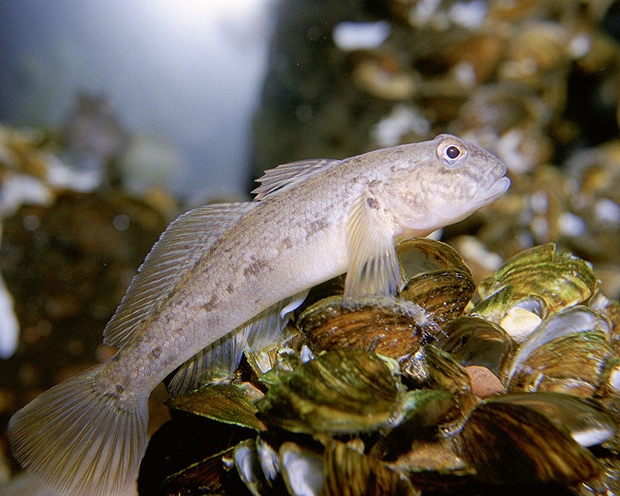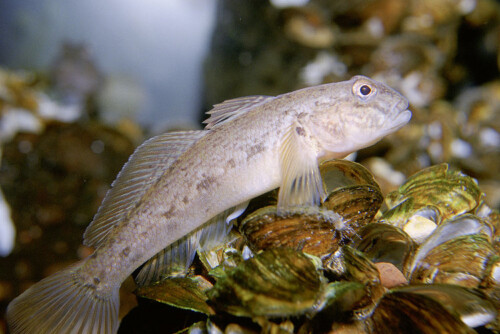Life on the St. Clair
Latency, I want to argue here, is important for thinking through the temporality of chemical infrastructures of reproduction that are at stake in the St. Clair River area. As the site of a dense chemical infrastructure, the St. Clair River is not only a crucial node in the perpetuation of the petrochemical network, it is also a landscape saturated with the effluent of past industrialization. Since the 1950s, through layers of industrial processes, the “excess” chemicals of production have been moved into the waters, airs, and ground of this region. At least since the 1950s, chemical dumping into the St. Clair has been a source of public anxiety and scientific study. In the 1970s, in the wake of Love Canal (located not far away), the storage of industrial sludge in the banks of the river came to light. The region is remarkable for its underground geology of salt deposits dotted with natural caverns in which industrial sludge can be stored underground. Under the earth’s surface, each of the 73 of these caverns on the Canadian side of the river holds the equivalent of three large surface petroleum tanks. In the 1960s, Lake Erie boomed with industry that built its way up the rivers that fed the lake. In 1969, an oil slick on the neighboring Cayuga River, then considered the most polluted river in the United States, caught fire in a location just before it poured into Lake Erie. Unregulated industrial excess made the rivers thick and flammable. Anxiety over this starkly visible chemical alteration of waterways helped to prompt early forms of environmental regulation including the first binational Great Lakes Water Quality Agreement of 1972, strengthened in 1978. The result of this regulation in the 1980s, was that effluent was pushed skyward: through stacks, into the air. Along the St. Clair, the sky is now decorated with plumes of billowing vapor.
Yet even in the 1980s, the past came back. In 1985, a toxic sludge congealment called the “Sarnia Blob” and the size of a basketball court appeared in the St. Clair River, following the leakage of liquid industrial waste into the river from a cavern operated by Dow Chemical. The Blob was formed following a leak of 2500 gallons of perchloroethelyene into the river, which then mixed with chemicals from previous spills to form a sludge of arsenic, copper, cadmium, chromium, iron, lead, mercury, nickel, zinc, polychlorinated biphenyls (PCBs), hexachlorobenzene, phosphorus, chromium, and manganese, oil, grease, and a cocktail of at least 30 toxic compounds known as polyaromatic hydrocarbons.1 Dow was fined $16,000 for the spill and spent another $1 million in vacuuming up the sludge. Maxwell Cohen, chairman of the international joint commission that revised the Water Quality Agreement in 1978, described the latent presence of toxic chemicals in the area as “the revenge of the industrial past” on the chemical present. “That revenge is finding a variety of forms,” he explained. “Companies that were legally in business 50 years ago […] dumped materials that now have proven to be lethal, or semi lethal […] No one controlled them 50 years ago, or 40 years ago, or even 30.”2 The past defers its violence into the present.
The post-World-War-II era of industrial exuberance has left behind a Great Lake rust belt of decrepit factories, unemployed towns, and chemical remainders for the twenty-first century. In the contemporary, river and lake sediment has become a contested site that materially archives this chemical past. To remove the sediment is to disturb it, and hence to release the toxic residues of the past back into animation. Yet the river and lake floors are not frozen in time—they continue to move and flow. PCBs, although banned in the late 1970s, continue to persist in the St. Clair River and across Lake Erie, with intensive accumulations along the shores and in canals. As a deep water shipping channel, the river’s sides actively erode or are purposefully dredged, and sediment is at stake. The chemical archive refuses to remain latent.
Despite its industrially altered nature, life continues within the ecosystem of the St. Clair. Organisms living in the benthic zone, the subsurface layers of the river bottom, busily absorb and reanimate chemical pasts. The more the benthic layer is revivified, the more it brings the latent past of chemicals back into the food chain, into fish, and then possibly to humans, who continue to fish the river’s waters, both for sport and subsistence.
Squeezed between Sunoco and Shell, the Aamjiwnaang First Nation is a small Ojibway community whose members’ ancestors have long lived along the St. Clair River. As a previously colonized community, the Aamjiwnaang First Nation (referred to in Canadian government documents by the bureaucratic name “Sarnia Indian Reserve 45”) now lays sovereign claim to its small territory of 1280.5 hectares wedged amidst the refining factories of major multinational corporations, such as Imperial Oil, Sunoco, Shell, and the old polymer plant. In recent years, environmental justice activists at the Aamjiwnaang First Nation have worked with local doctors, scientists, and lawyers to document the first known case of a dramatic reduction in birth ratio of boys to girls that is not associated with a specific acute industrial or nuclear accident. Between 1999 to 2003, of the 100 children born in the community, only 35 were boys.3 The chemical past thus manifests in the present though an absence: lives not born.
This community sits at the cross-hairs of multiple scales of governmentality: that of First Nation governance; of Ontario and Canadian environmental regulation; of the United States and Michigan, which control the other side of the river; and of Ohio on Lake Erie, each involving different state agencies and histories. As the United States’ largest supplier of oil, Canada remains deeply invested in spatializing less-regulated regions for its production and refinement. In Chemical Valley, an industry consortium, not the state, records air quality levels. Knowledge production about this site, thus, is deeply contaminated with industry.
Therefore, what we know about the chemical infrastructure of Chemical Valley must also come from Aamjiwnaang environmental activists; ecologists; local NGOs; and transnational NGOs, such as Global Community Monitor, who are attempting to document a soup of chronic chemical exposures, which is almost entirely unmeasured by the Canadian government, using techniques such as grassroots bucket sampling.4 At the Aamjiwnaang First Nation, the violent effects of externalized chemical excess have been tracked in the last decade by locally crafted community health surveys and by body maps, which have documented the embodied effects of living in Chemical Valley. It is difficult to sustain such efforts as it is difficult to raise funding, and locals must continue to find work in the plants of Chemical Valley. While efforts like bucket sampling can catch snapshots of the chemical exposures of the present and community health surveys track accumulated health responses, neither type of knowledge provides data with the needed temporal arrow: past exposure leads to later health problem. Environmental justice activists have learned the painful lesson that chemical injury is not just displaced spatially with super stacks, toxic trading, and selective plant placement. Chemical injury is displaced temporally, such that accountabilities exceed the scope of individual lives, bioaccumulating or persisting over time, beyond regulatory regimes, into the long future.
Yet Aamjiwnaang activists have been joined by indigenous activists across Canada who have mobilized in resistance to the Alberta Tar Sands, whose pipelines stretch from the Pacific to Sarnia and thus join dispersed communities together in common political cause. This activism manifests a new historical era of indigenous politics, an era named in a past Anishnabe prophecy as a time of environmental devastation in which the seventh generation since colonization would rise up. The future foretold has arrived in this moment of intensive, geographically dispersed activism by First Nation communities in Canada in defense of their constitutionally protected treaty rights against petrochemical capitalism. This activism has galvanized into the Idle No More movement, a name that makes explicit a temporal transformation into resistance.5
If the lives not born of the Aamjiwnaang nation are the effect of past releases of chemicals, the temporal lag makes putting cause and effect together elusive. And this is the rub for chemicals that act as reproductive toxins or that can trigger cancers. The effects are not necessarily felt at the moment of the exposure, but later, in the future. Within the uneven spatial and temporal extensions of chemicals, people are “living in prognosis,” as anthopologist Lochlan Jainn explains.6 They are living structurally in the unknown individual probability of a statistical possibility, waiting for a symptom to arrive that can only point retrospectively and conjecturally to a possible harm.
In the case of endocrine-mimicking chemicals this latency is intensified, as endocrine-mimicking chemicals have a particularly intense effect on shaping developing fetal life—life not yet born, and hence future life. Endocrine-mimicking chemicals, then, can manifest health effects in the next generation. The embodied response may not even be felt until the next future generation—possible grandchildren not born. For example, research into the effects of the estrogenic chemical bisphenol A (BPA) on pregnant mice has found that the significant effects occur not so much for the fetus in utero, but for the eggs that are being formed inside that fetus, and, hence, the effects are manifested in the potential grandchildren who will not be born.7 Here, lives not born along the St. Clair may well be the effect of exposures endured by their grandmothers. Hence, the sex ratio effects experienced by the Aamjiwnaang nation may be the latent response of exposures two generations ago. Or it could be the effect of continuous, multiple, accumulated, multigenerational exposures crossing a threshold that has not become an epistemologically legible measure.
The possible role of past exposures to endocrine-disrupting chemicals in the lives not born among the Aamjiwnaang is difficult to prove. Nearby Sarnia shows no such change in sex ratio. Other known cases of human sex ratio changes have been linked to acute occupational exposures or industrial accidents. Almost no state-funded research has been conducted to help study this issue. In contrast, the study of sex ratio change and other effects of reproductive toxins is flourishing in local freshwater biology research. On the St. Clair, herring gulls have been found to have a reduction in males, and a greater portion of male embryo death. Snapping turtles are “feminized.” White perch have a 45 percent rate of intersex in the St. Clair.8 Thus, across multiple animal orders—birds, fish and reptiles— not only has life been altered in intergenerational time, but the material ability to continue life in time, to reproduce, has also been rearranged.
The round goby has emerged as a particular sentinel for endocrine-disrupting chemicals in Great Lake waterways. The round goby is a fish from Europe, first found in the St. Clair River in 1990, likely transported there in the ballast water of ships. Since then, the round goby has rapidly come to occupy all five of the Great Lakes. Gobys are bottom feeders. In other words, they feed off the layer of microorganisms and the mussels that live in the surface sediment of the benthic zone. The term bottom feeder, moreover, has a cultural resonance, designating a kind of “lowlife,” or low-status life. As an invasive species and a lowlife, the goby is criminalized and racialized in ecological management discourse. The goby is a “suspect,” an “illegal” and unwanted “immigrant” that ecological management policies wish to eradicate.9 The benthic zone mussels which the round goby eats are, in turn, filter-feeding invertebrates known to bioconcentrate contaminants. Thus, chemicals have found a new route of bioaccumulation in the round goby. The round goby is charged with the crime of resurrecting the chemical past. At the same time, the round goby is so successful as an invasive species because it is relatively pollution-tolerant, finding garbage-filled river bottoms to be good nesting sites.

The round goby has become a sentinel for chemical contaminants because populations show signal sex changes in response to endocrine disrupting chemicals. Ecologists capture round goby samples in sites expected to have high levels of contamination and perform a variety of tests that cannot be done on human bodies, including dissection and measure of chemical load in tissue and livers, as well as assessment of the condition of gonads. In particular, a shorter length of the male urogenital papilla; a changed proportion of one of the male goby genders (that scientists label “male gender #2”); a skewed sex ratio (which has a rare, higher rate of females in the Detroit River); and the presence of eggs and sperms in male goby testes are signals of the presence of endocrine-disrupting chemicals.10 So, too, is the presence of vitellogenin, an egg yolk precursor protein synthesized in the liver, which is not expressed in males unless exposed to a xeno-estrogen. In the last few years, students working at local universities have developed a bioassay for the presence of vitellogenin in the round goby.11 Thus, the round goby, which lives only two to three years, is becoming a “signature of contamination” organism for the Great Lakes, a living assay that provides a way to sample and map the presence of endocrine disrupters.
The round goby is a queer survivor. Scientists describe the goby as having multiple male genders (or “morphs”), and it is this arrangement of male genders that is altered in contaminated landscapes.12 It thrives intergenerationally despite alterations to its embodiment and chemical injuries to individuals. While scientists tend to biologize animal sex and gender (as scientists see it, only some organisms reproduce sexually), in contrast I argue that what is crucial to the politics of distributed reproduction is not the maintenance of proper heteronormative human and nonhuman bodies, but instead is the sustaining of capacities to live intergenerationally. Chemically caused sex ratio change, then, is reframed as a question of how unchosen rearrangements to the embodiment of nonhumans and humans can be acts of structural violence that destroy the possibility of future life and produce life unborn. At stake is a simultaneous recognition of intergenerational injury and a valuing of queer, altered, and othered life. The figure of life unborn, then, expands from a concern of the conventional politics of abortion (and a figure of the Christian right) to a concern of the politics of sustaining multigenerational life and already altered life within uneven conditions of past, present, and recurring violence patterned in the material work of capitalism.
Waiting for Change
From toxic blobs, to the multigenerational capacity to sustain life, to the persistence of sediments into the future, chemical infrastructures of reproduction are shaped by time and latency. A goby assay or a bucket sample can show recent or immediate exposure. A community health chart or sex ratio study can show the bodily effects of a past event. Therefore, there is a crucial temporal gap in knowledge-making that shapes the ways that both reproductive and environmental politics are imagined. While sediment holds unregulated contaminants from the past whose violence is releasable into the present, latency is only a problem. Latency can become a source of interruption into the repetition of the same—for good or bad. Chemical infrastructures of reproduction do not just make reproduction possible; they distribute reproduction in uneven and specific ways across both time and space. Living among the many infrastructures that redistribute reproduction, there are many pasts at work, not only chemical, with which to reanimate our futures.
If, in studying reproduction and participating in reproductive politics, one aims not just to reproduce the same, not just to give in to the breathless futurism of contemporary anticipatory impulses, then how might our attention to the responsiveness and generativity of life in contemporary technoscience be interrupted, supplemented, and reoriented? There is a politics to latency: neither generativity nor difference are in themselves ethical. Which pasts need to be pulled out of the sediment into activity? What pasts can be drawn into new action? If reproduction is distributed, what are we waiting for?
- Environment Canada and Ontario Ministry of Environment, “Pollution of the St. Clair River (Sarnia Area),” Ontario Ministry of Environment (1985). [↩]
- Radio Interview, “As It Happens,” 19, Mar. 1979, CBC Digital Archives, last modified 14 Feb. 2012. Available at http://www.cbc.ca/archives/categories/environment/pollution/troubled-waters-pollution-in-the-great-lakes/revenge-of-the-industrial-past.html. [↩]
- Constanze Mackenzie, Ada Lockridge, and Margaret Keith, “Declining Sex Ratio in a First Nation Community,” Environmental Health Perspectives 113.10 (2005): 1295-1298. [↩]
- Aamjiwnaang First Nation Health and Environmental Committee, http://www.aamjiwnaangenvironment.ca/index.html; Global Community Monitor, “Aamjiwnaang First Nation Bucket Brigate,” last modified 10 May 2007, available at http://www.gcmonitor.org/article.php?id=582. See the environmental justice work of Ada Lockeridge and Ron Plain; Isaac Luginaah, Kevin Smith, and Ada Lockridge, “Surrounded by Chemical Valley and ‘Living in a Bubble’: The Case of the Aamjiwnaang First Nation, Ontario.” Journal of Environmental Planning and Management 53.3 (2010): 353-70; Dayna Nadine Scott, “’Gender-Benders:’ Sex and Law in the Constitution of Polluted Bodies,” Feminist Legal Studies 17 (2009): 241-26; and the film The Beloved Community by Pamela Calvert/Plain Speech (California Newsreel, 2007). [↩]
- Idle No More, accessed January 6, 2013, http://idlenomore1.blogspot.com/. [↩]
- Jain, Sarah Lochlann. “Living in Prognosis: Toward an Elegiac Politics.” Representations 98.1 (2007): 77-92. [↩]
- Martha Susiarjo et al., “Bisphenol a Exposure in Utero Disrupts Early Oogenesis in the Mouse,” PLoS Genetics 3.1 (2007). [↩]
- See, for example, Canada, Environment. “Great Lakes Fact Sheet: Fish and Wildlife Health Effects in the Canadian Great Lakes Areas of Concern” (2003); SR De Solla, C.A. Bishop, and R.J. Brooks, “Sexually Dimorphic Morphology of Hatchling Snapping Turtles (Chelydra Serpentina) from Contaminated and Reference Sites in the Great Lakes and St. Lawrence River Basin, North America,” Environmental Toxicology and Chemistry 21.5 (2002): 922-29.; RJ Kavanagh, et.al., “Endocrine Disruption and Altered Gonadal Development in White Perch (Morone Americana) from the Lower Great Lakes Region,” Environmental Health Perspectives 112.8 (2004): 898-902; DV Weseloh, C. Perkarik, and SR. De Solla, “Spatial Patterns and Rankings of Contaminant Concentrations in Herring Gull Eggs from 15 Sites in the Great Lakes and Connecting Channels, 1998-2002,” Environmental Monitor Assessment 113 (2003): 265-84. [↩]
- Illinois-Indiana Sea Grant, “Gabby ‘The Low Life’ Round Goby,” accessed January 6, 2013, http://www.iiseagrant.org/nabinvader/Lakes/suspects/suspect_gabby.html. [↩]
- JR Marentette et.al., “Signatures of Contamination in Invasive Round Gobies (Neogobius melanostomus): A Double Strike for Ecosystem Health?” Ecotoxicology and Environmental Safety 73.7 (2010): 1755-64; and Andrew MacInnis and Lynda Corkum, “Fecundity and Reproductive Season of the Round Goby Neogobius melanostomus in the Upper Detroit River,” Transactions of the American Fisheries Society 129 (2000): 136-144. [↩]
- LA Bowley et.al., “Characterization of Vitellogenin Gene Expression in Round Goby (Neogobious Melanostomus) Using a Quantitative Polymerase Chain Reaction Assay,” Environmental Toxicology and Chemistry 29.12 (2010): 2751-60. [↩]
- JR Marentette, JL Fitzpatrick, RB Berger, and S. Balshine, “Multiple Male Reproductive Morphs in the Invasive Round Goby (Apollonia melanostoma),” Journal of Great Lakes Research 35 (2009): 302-308. [↩]





